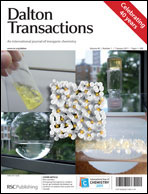The reaction of [n-Bu2SnO]n with 1,5-naphthalenedisulfonic acid tetrahydrate in a 1 : 1 stoichiometry followed by reaction with 2,2′-bipyridine-N,N′-dioxide (BPDO-I) afforded a 1D-coordination polymer [n-Bu2Sn(BPDO-I)(1,5-C10H6(SO3)2)]n (1) where the disulfonate ligand acts as a bridging ligand between two tin centers. An analogous reaction involving [Ph2SnO]n afforded a trihydrated O,O′-chelated diorganotin cation [{Ph2Sn(BPDO-I)(H2O)3}2+][C10H6(SO3−)2]·2CH3OH (2·2CH3OH). Utilizing two equivalents of BPDO-I in this reaction resulted in the ionic complex [{Ph2Sn(BPDO-I)2(H2O)}2+][C10H6(SO3−)2]·3H2O (3·3H2O). In 2 and 3 the sulfonate ligands are not present in the coordination sphere of tin. Reaction of [n-Bu2SnO]n and 1,5-naphthalenedisulfonic acid tetrahydrate, followed by reaction with [bis(diphenylphosphoryl)methane (DPPOM)] resulted in the formation of, [{n-Bu2Sn(DPPOM)2(H2O)(1,5-C10H6(SO3)(SO3−)}]·H2O (4·H2O). Of the two coordinating groups present in DPPOM, only one P![[double bond, length as m-dash]](https://www.rsc.org/images/entities/char_e001.gif) O group is coordinated to the tin atom. The remaining P
O group is coordinated to the tin atom. The remaining P![[double bond, length as m-dash]](https://www.rsc.org/images/entities/char_e001.gif) O motif is free and is involved in intramolecular H-bonding with the tin-bound water molecule. Using [Ph2SnO]n instead of [n-Bu2SnO]n afforded the ionic complex [{Ph2Sn(DPPOM)2}2+{1,5-C10H6(SO3−)2}] (5) where the DPPOM functions as a chelating ligand. The reaction of [n-Bu2SnO]n with 1,5-naphthalenedisulfonic acid tetrahydrate followed by addition of one equivalent of 8-hydroxyquinoline (8-HQ) in presence of triethylamine afforded the neutral dinuclear complex, [(H2O)(8-Q)n-Bu2Sn(μ-1,5-C10H6(SO3)2)n-Bu2Sn(8-Q)(H2O)] (6) where the two tin atoms are bridged by the disulfonate ligand. Compounds 1–6 are thermally stable as shown by their thermogravimetric analyses.
O motif is free and is involved in intramolecular H-bonding with the tin-bound water molecule. Using [Ph2SnO]n instead of [n-Bu2SnO]n afforded the ionic complex [{Ph2Sn(DPPOM)2}2+{1,5-C10H6(SO3−)2}] (5) where the DPPOM functions as a chelating ligand. The reaction of [n-Bu2SnO]n with 1,5-naphthalenedisulfonic acid tetrahydrate followed by addition of one equivalent of 8-hydroxyquinoline (8-HQ) in presence of triethylamine afforded the neutral dinuclear complex, [(H2O)(8-Q)n-Bu2Sn(μ-1,5-C10H6(SO3)2)n-Bu2Sn(8-Q)(H2O)] (6) where the two tin atoms are bridged by the disulfonate ligand. Compounds 1–6 are thermally stable as shown by their thermogravimetric analyses.

You have access to this article
 Please wait while we load your content...
Something went wrong. Try again?
Please wait while we load your content...
Something went wrong. Try again?
![[double bond, length as m-dash]](https://www.rsc.org/images/entities/char_e001.gif) O group is coordinated to the tin atom. The remaining P
O group is coordinated to the tin atom. The remaining P![[double bond, length as m-dash]](https://www.rsc.org/images/entities/char_e001.gif) O motif is free and is involved in intramolecular H-bonding with the tin-bound
O motif is free and is involved in intramolecular H-bonding with the tin-bound 

 Please wait while we load your content...
Please wait while we load your content...